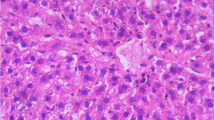Abstract
Vernonia amygdalina or commonly known as “bitter leaf” in Malaysia has been widely used for the treatment of malaria and diabetes mellitus. The objective of this study was to examine the possible toxic effect of methanol leaves extract of V. amygdalina after 28 days oral administration in female Sprague Dawley rats. This 28 days toxicity study of V. amygdalina was conducted according to OECD 407 guidelines. Sub-chronic effects of methanol leaf extract of V. amygdalina on liver and kidney functions in female Sprague Dawley (SD) rats were examined by measuring the serum levels of AST, ALT, ALP, total bilirubins, urea, creatinine, total cholesterol and triacylglycerol in both control and treatment groups. Based on the results obtained, 28 days administration of V. amygdalina (300, 600 and 1200 mg/kg bw) did not cause any significantly changes in serum biochemical parameters, body weight changed and relative organ weight when compared to the control group. In conclusion, sub-chronic (28 days) oral administration of methanol leaves extract of V. amygdalina at a dose up to 1200 mg/kg exhibited no adverse effects on liver and kidney functions in female SD rats.


Similar content being viewed by others
References
Abdulrahman FI, Onyeyili PA, Sanni S, Ogugbuaja VO (2007) Toxic effect of aqueous root-bark extract of Vitex doniana on liver and kidney functions. Int J Biol Chem 1:184–195
Adaramoye O, Achem J, Akintayo O, Fafunso MA (2010) Lipid lowering effect of methanolic extract of Vernonia amygdalina leaves in rats fed on high cholesterol. Artherosclerosis 2:17–108
Atangwho IJ, Egbung GE, Ahmad M, Yam MF, Asmawi MZ (2013) Antioxidant versus anti-diabetic properties of leaves from Vernonia amygdalina Del growing in Malaysia. Food Chem 141:3428–3434
Erasto P, Grierson AJ, Afolayan AJ (2006) Bioactive sesquiterpene lactones from the leaves of Vernonia amydalina. J Ethnopharmacol 106:117–120
Etuk EU, Mohammed BJ (2009) Informant consensus selection method: a reliability assessment on medicinal plants used in north western Nigeria for the treatment of diabetes mellitus. Afr J Pharm Pharmacol 3:496–500
Ho WY, Liang SW, Yeap SK, Beh BK, Yousr AHN, Alitheen NB (2012) In vitro and in vivo antioxidant activity of Vernonia amygdalina water extract. Afr J Biotechnol 11:4090–4094
Izevbigie FB (2003) Discovery of water-soluble anticancer agents (edotides) from a vegetable found in Benin City Nigeria. Exp Biol Med 228:293–298
Karaman I, Sahin F, Gulluce M, Ogutcu H, Sengul M, Adiguzel A (2003) Antimicrobial activity of aqueous and methanol extracts of Juniperus oxycedrus L. J Ethnophamacol 85:231–235
Katila DB, Megersa YC (2014) Pathological and serum biochemical study of liver fluke infection in ruminants slaughtered at ELFORA Export Abattoir, Bishoftu, Ethiopia. Global J Med Res 14:6–20
Njan AA, Adzu B, Agaba AG, Byarugaba D, Diaz-Llera S, Bangsberg DR (2008) Analgesic and antiplasmodial activities and toxicology of Vernonia amygdalina. J Med Food 11:574–581
OECD 407 (2008) Guidelines for the testing of chemicals. Repeated dose 28-day oral toxicity study in rodents
Ola SS, Giaccherini C, Innocenti M, Vincieri FF, Akindahunsi AA, Mulinacci N (2009) HPLC/DAD/MS characterization and analysis of flavanoids and cynnamoil derivatives in four Nigerian green-leafy vegetables. Food Chem 115:1568–1574
Omolola A, Adesanoye, Ebenezer O, Farombi (2010) Hepatoprotective effects of Vernonia amygdalina (astereaceae) in rats treated with carbon tetrachloride. J Exp Toxicol Pathol 62:197–206
Swee KY, Wan YH, Boon KB, Woon SL, Huynh KY, Abdul HNY, Noorjahan BA (2010) Vernonia amygdalina, an ethnoveterinary and ethnomedical used green vegetable with multiple bioactivities. J Med Plants Res 4:2787–812
Timbrell JA (2009) Principles of biochemical toxicology, 4th edn. Informa Healthcare, New York, pp 43–5
World Health Organisation (2000) General guidelines for methodologies on research and evaluation of traditional medicine. Geneva; p. 35
Acknowledgments
The authors thank the Centre of Excellence for Research, Value Innovation and Entrepreneurship (CERVIE), UCSI University, for awarding the research grant (Proj-In-FPS-004) to complete this study.
Author information
Authors and Affiliations
Corresponding author
Ethics declarations
Ethical Statement
All the procedures for the present toxicity studies were approved by the Faculty Research and Animal Ethical Committee, UCSI University, Malaysia and performed in accordance with ethical standards laid down in the 1964 Declaration of Helsinki and its later amendments.
Conflict of Interest
The Authors declare that they have no conflict of interest.
Rights and permissions
About this article
Cite this article
Akowuah, G.A., May, L.L.Y. & Chin, J.H. Toxicological evaluation of Vernonia amygdalina methanol leave extract in rats. Orient Pharm Exp Med 15, 365–369 (2015). https://doi.org/10.1007/s13596-015-0194-6
Received:
Accepted:
Published:
Issue Date:
DOI: https://doi.org/10.1007/s13596-015-0194-6




